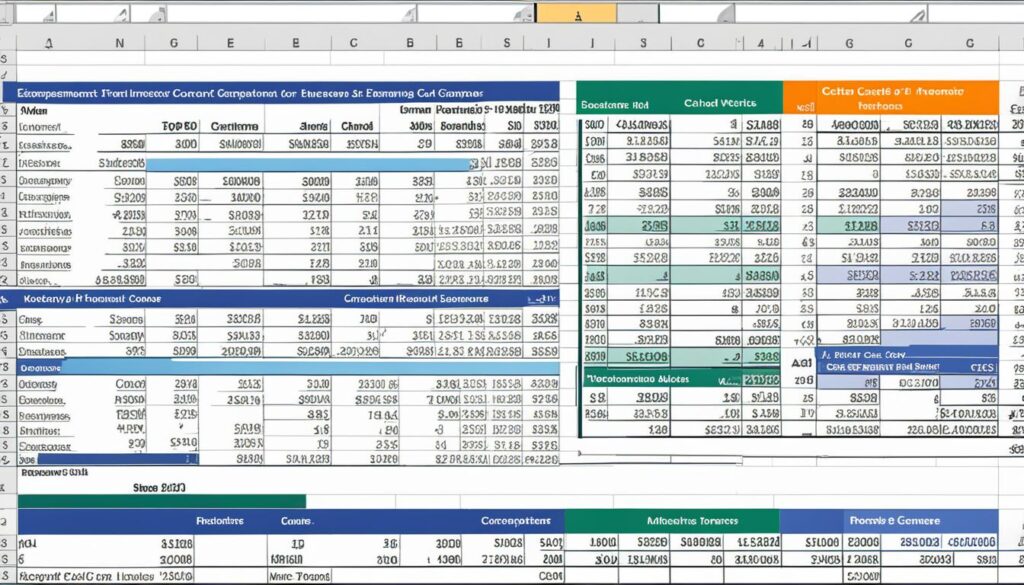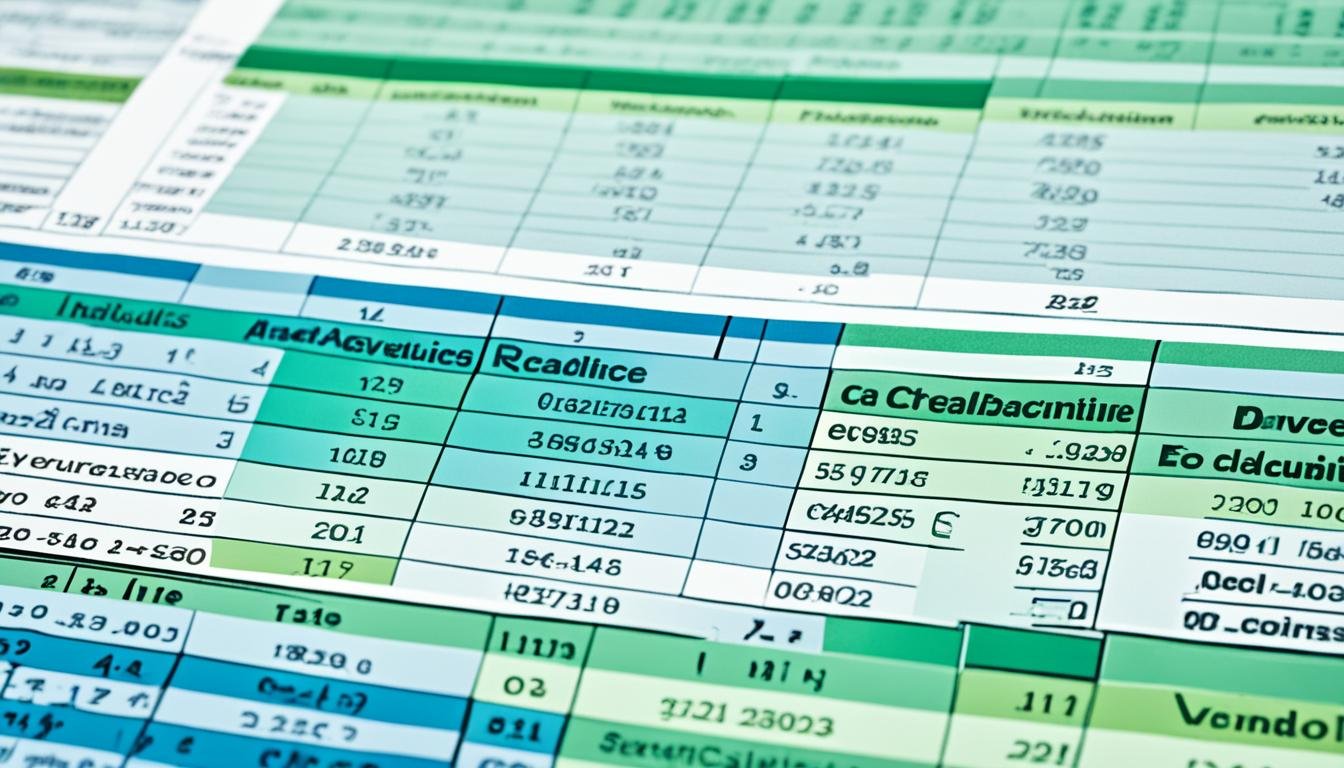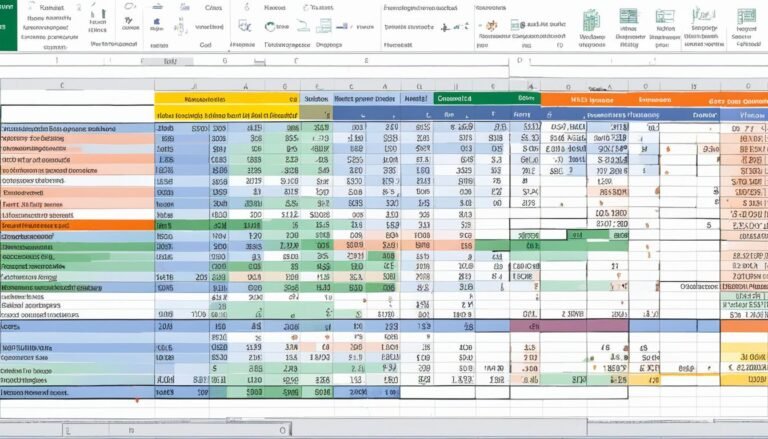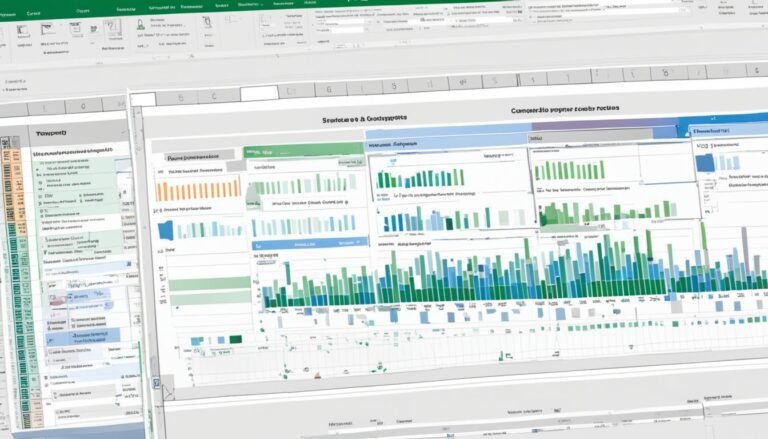Using Excel for Accounting: A Comprehensive Guide
I’ve taught Excel to companies and people for over 12 years. Excel is key in accounting, especially for new businesses. It helps manage money, make reports, and improve spreadsheets.
Learning Excel well early on saves time later. This guide will show you how to use Excel for accounting. You’ll learn about data and financial reports, plus important formulas.
Key Takeaways
- Excel is vital for accountants to handle money and make reports.
- Getting good at Excel early makes accounting work easier and faster.
- This guide includes data handling, making things look right, and using Excel’s advanced features.
- Tips: Use templates, formulas, and functions to make accounting easier.
- Also, follow the best advice to boost your Excel skills for accounting jobs.
Introduction to Using Excel for Accounting
I’ve spent over 12 years teaching using Excel for accounting to companies and people. I firmly believe that it’s crucial in today’s business scene. Despite its old-school appearance, Excel is key for many financial tasks. It helps with handling money info, making reports, and improving spreadsheets.
Why Excel is Essential for Accountants
In accounting, being fast and right is everything. Excel’s many tools and solid design make it a must-have for accountants. It allows for easier work and top-notch results. Whether it’s about complex data or detailed reports, Excel for accountants is life-changing.
Benefits of Mastering Excel for Accounting
Getting good at using Excel for accounting brings lots of benefits. It boosts your productivity, upgrades your financial reviews, and spikes your reporting game. Knowing Excel well makes you a top player in finance. The importance of Excel in accounting is just huge.
Once you master Excel, accounting work gets simpler. It also helps you make smart choices based on data. You can do things like manage accounts better or predict cash flow. The excel accounting benefits really pay off.
Excel’s versatility and robust features make it an essential tool for accountants, helping them streamline their workflows and deliver high-quality work.
If you dedicate time to be great at Excel, it enhances your accounting career. This stands true for both veterans and beginners. Excelling at using Excel for accounting keeps you at the front and shining in finance’s competitive field.
Data Management with Excel
I have taught MS Excel for more than 12 years to groups and people. It is key for accountants to manage data well. Excel has many powerful tools for precise and neat data work. This makes financial analysis and reports easier and faster.
Data Validation and Error Prevention
Excel’s data validation helps keep data right and stops mistakes. It uses rules to check data entered, keeping everything tidy and matching what’s needed. This is crucial with money data, as small errors can cause big problems.
Data validation rules in Excel act as gatekeepers, safeguarding your spreadsheets from erroneous entries and maintaining the reliability of your financial records.
Pivot Tables for Financial Analysis
Excel pivot tables change how we look at big amounts of data. They help to show data in clear and useful ways. This lets you see trends, patterns, and odd data easily. With this, you can take steps based on good info.
Lookup Functions: VLOOKUP and HLOOKUP
Finding exact data in heaps of financial records can be hard. VLOOKUP and HLOOKUP in Excel are great for this. They let you quickly find and use data from tables or databases. This saves time and effort.
- VLOOKUP searches for a value in the leftmost column of a table and returns a corresponding value from the same row.
- HLOOKUP, on the other hand, searches for a value in the topmost row of a table and retrieves a corresponding value from the same column.
Learning to use these Excel tools will help you handle financial data better. It will make your reports more precise and on time for your organization.
Formatting and Visualization
Excel conditional formatting and excel charts and graphs help turn complex numbers into understandable stories. They make it easy for others to quickly get the meaning behind financial data. With these tools, stakeholders can learn from data faster.
Conditional Formatting for Highlighting Trends
Excel lets me use conditional formatting to mark important trends. I can highlight key data using colors or icons. This makes it easy to see what needs focus or action in reports.
Creating Charts and Graphs
Charts and graphs simplify heavy financial data, aiding better decisions. Excel’s varied charts help present data clearly. Selecting the right type makes numbers clear, helping stakeholders understand easily.
I use both conditional formatting and charts in reports for a vivid story. These tools help me share insights effectively. They highlight trends and drive better decisions.
| Visualization Technique | Use Case | Advantages |
|---|---|---|
| Conditional Formatting | Highlighting exceptions, trends, and outliers in financial reports | Draws immediate attention to critical data points, enabling quick identification of areas that require action |
| Bar Charts | Comparing values across categories or time periods | Clear and intuitive representation of data, making it easy to spot highs and lows at a glance |
| Line Charts | Visualizing trends and patterns over time | Effectively conveys the progression of data, allowing for trend analysis and forecasting |
| Pie Charts | Showing proportions or percentages of a whole | Provides a simple and digestible representation of how values contribute to a total |
Knowing Excel’s data formatting and visualization boosts my storytelling. This impresses stakeholders, promoting smart decisions and business growth.
Automating Tasks with Excel
Time is precious in the world of accounting and finance. I’ve taught MS Excel for over 12 years. Excel macros and the Solver tool revolutionize how we work efficiently. They automate tasks and solve complex problems with ease.
Macros for Repetitive Tasks
Doing the same steps over and over is boring and can lead to mistakes. Excel macros give you a better way. They let you record and replay steps, saving you time and reducing errors.
Macros are great for making reports look consistent, moving data between sheets, or doing tough math quickly. They help you focus on more important work by doing the grunt work for you. This makes your work smoother and boosts your productivity.
Using the Solver Tool
Finance often has tough problems to solve. The Excel Solver tool helps find the best solutions. It lets Excel figure out the best answers based on your objectives and limits.
It’s useful for making more money, saving on costs, or using your resources better. The Solver tool makes tasks like budgeting and making plans much easier. It helps you make smart choices and reach your goals.
By using Excel macros and the Solver tool, Excel becomes a smart tool for every finance need.
Using automation and smart tools in Excel makes your work better. It makes you good at solving complex problems. In finance, being efficient and smart is key. Using automating tasks in Excel can give you a big advantage.
Using Excel for Accounting
Having worked with Excel for over 12 years, I know its impact on accounting. We will look at how Excel makes reconciling bank accounts, tracking receivables, and managing payables easier.
Reconciling Bank Accounts
Maintaining accurate bank records is key for all businesses. Excel makes bank reconciliation easy. It allows you to check transactions against bank statements to find mistakes. Excel’s tools help spot errors quickly.
Tracking Accounts Receivable
Staying on top of unpaid bills is crucial for cash flow. Excel offers tools for accounts receivable tracking, like aging analysis and customer balances. These help prevent bad debts by letting you track payments and follow up with clients.
Managing Accounts Payable
Excel is also great for handling what you owe. It lets you track vendor payments easily. This ensures you pay on time, helping your business’s reputation and relationships with suppliers.
Excel templates and functions simplify accounting, saving time, and improving accuracy and control.
| Accounting Process | Excel Functionality | Benefits |
|---|---|---|
| Bank Reconciliation | Sorting, Filtering | Identify discrepancies, ensure accuracy |
| Accounts Receivable Tracking | Aging Analysis, Customer Balances | Monitor outstanding payments, improve cash flow |
| Accounts Payable Management | Vendor Balances, Due Date Tracking | Avoid late fees, maintain supplier relationships |
Excel’s tools help in these key areas. They streamline accounting, improve control, and support better business decisions.
Financial Reporting with Excel
I’ve taught MS Excel for 12 years to businesses and people. I know it is vital for financial reports. Excel helps create key reports like income statements and balance sheets. It’s great for cash flow statements too.
Creating Income Statements
To make an income statement excel that stands out, use Excel’s formula and chart features. It lets you show what money came in and what was spent. This helps you see if your business is making a profit.

Balance Sheet Generation
Excel is also good for balance sheet excel reports. It helps list your company’s stuff and debts clearly. Its tools highlight important details. This makes understanding the report easier.
Cash Flow Statement Templates
Making cash flow statement excel templates in Excel is easy. It uses simple money tracking. This shows how money moves in and out of your business. These reports give clues about how well you’re managing money.
| Financial Statement | Purpose | Key Excel Features |
|---|---|---|
| Income Statement | Evaluate profitability | SUM, SUMIF, SUMIFS, Charting |
| Balance Sheet | Analyze financial position | Asset/Liability classification, Weighted capital cost calculation |
| Cash Flow Statement | Monitor cash flow | Cash receipts journals, Disbursements registers |
Excel is a powerful tool for financial reporting. It helps businesses, big and small, make smart choices and grow. Its features are strong yet easy to use.
Advanced Excel Techniques
Excel is a powerful tool for calculations and data analysis. With over 12 years teaching experience, I’ve seen how advanced Excel features change the game. Let’s dive into array formulas, dynamic named ranges, and advanced pivot table techniques in this section.
Array Formulas for Complex Calculations
Array formulas are great for complex calculations. They let you do a lot in one cell, cutting down long formula chains. They’re perfect for tasks like finding the biggest or smallest number in a group, counting how many times something happens, or doing detailed maths.
Dynamic Named Ranges
Named ranges are already useful for giving names to cells or ranges. But with dynamic named ranges excel, they can keep up with changing data. This means your formulas don’t break when your data grows or shrinks.
Advanced Pivot Table Techniques
Pivot tables aren’t just for simple summaries. Advanced pivot tables let you make complex structures, add new calculated fields, and blend data from different places. This helps you see more in your data, spotting trends and details you might have missed.
Mastering these advanced Excel techniques can be a game-changer, empowering you to work more efficiently, make better-informed decisions, and ultimately drive your business forward.
If you work with lots of data, like an accountant or analyst, learning these advanced techniques is worth it. It boosts your productivity and helps you dig deeper into your numbers.
Best Practices for Accounting in Excel
Having taught MS Excel for more than 12 years, I know how crucial it is to use the software wisely. The right Excel practices can make your accounting work smoother. They can also help you make better decisions and boost your business.
Data Consolidation and Integration
Bringing data together from different places is key in accounting. Luckily, Excel has a set of functions like SUMIFS and COUNTIFS. These let you merge specific data points accurately. This makes data consolidation in Excel a breeze. You can combine financial data from various parts of your company. This makes it easier to see the big picture and to write detailed reports.
What-If Analysis and Scenario Planning
Excel is great for playing out different financial scenarios. Tools like Goal Seek and Scenario Manager help with this. They let you change input data to see how it affects your outcome. This is perfect for planning, assessing risks, and finding the best strategies for financial success.
Data Visualization with Power BI and Tableau
Excel is amazing for crunching numbers. But, when you combine it with tools like Power BI and Tableau, your reports can become visually stunning. You can make interactive dashboards and reports out of your Excel data. This improves data visualization excel. Visualizing data clearly helps you share insights with stakeholders. This leads to smarter decisions.
| Feature | Description | Benefits |
|---|---|---|
| Data Consolidation | Combining data from multiple sources using SUMIFS and COUNTIFS functions | Comprehensive analysis, accurate reporting |
| What-If Analysis | Goal Seek and Scenario Manager for exploring financial scenarios | Informed decision-making, risk assessment |
| Data Visualization | Power BI and Tableau for creating interactive dashboards | Clear communication of insights, better stakeholder engagement |
Excel Tips from Accounting Experts
After teaching Excel for over 12 years, I’ve learned some excel tips for accountants from top pros. These tips are great for the monthly close. They will make your work better and the accounting process smoother.
Experts really know how to use Excel for advanced conditional formatting formulas. These formulas help point out important info in financial reports. This makes it easy to see what needs more attention, improving your analysis and decision-making.
Conditional formatting changes the game. It lets you see the most important info clearly. This saves you time by not having to search through tons of data.
Accountants find the Scenario Manager super useful too. It helps with strategic planning by looking at different “what-if” scenarios. This can help you spot risks and opportunities, allowing you to make smart choices with solid data behind them.
Also, mastering variance and general ledger analysis in Excel is key. By using tools like pivot tables, advanced filters, and formulas, you can really dig into the numbers. This way, you can find any mistakes and get a full picture of the company’s finances.
| Technique | Description | Benefits |
|---|---|---|
| Pivot Tables | Summarize and analyze large datasets | Identify trends, patterns, and outliers |
| Advanced Filters | Extract specific data based on complex criteria | Isolate and analyze relevant information |
| Formula-driven Analysis | Automate calculations and data manipulation | Streamline processes and reduce errors |
Learning from accounting expert advice and improving your Excel skills can take your work to new heights. It leads to more efficiency, accuracy, and insight in your accounting work.
Conclusion
Mastering Excel for accounting is crucial after teaching it for years. Excel accounting skills are key now, with data being so important. This guide has shown you vital and advanced Excel skills for accounting.
You’ve learned from data management to making financial reports easier. With Excel, you can make work smoother, boost analysis, and get great results. Excel helps in many areas like checking accounts, following up on payments, and making financial reports.
Learning mastering excel for accounting improves what you already do. It also makes you a big plus in the finance world. Keep your excel accounting skills sharp. Learn new things and stay updated with the latest Excel features and tips. Excel is here to help you with smart decisions using data.
FAQ
Why is Excel essential for accountants?
Excel is key in many accounting offices for new business ventures. It is vital for handling financial data and creating reports. Early Excel skills save time and make work easier.
How does Excel proficiency benefit accountants?
Being good at Excel is crucial in today’s fast-changing business world. It’s not just about tradition. Excel helps with data management, making reports, and improving spreadsheets. It makes your work better and you more valuable in finance.
What are some essential data management tools in Excel for accountants?
Data validation stops errors and controls what you can enter in cells. Pivot tables turn big data into insights by analyzing and showing trends. VLOOKUP and HLOOKUP help by quickly finding info in big tables. These are must-know tools for accountants using Excel.
How can Excel enhance financial reporting and analysis?
Conditional formatting makes key points stand out in reports. This includes trends or unusual data using colors or symbols. Charts and graphs turn complex data into clear visuals. This makes reporting and analysis better.
What are some automation tools in Excel useful for accountants?
Macros let you automate repetitive tasks. They record your actions and then repeat them, saving time. The Solver tool is great for solving complex problems in your financial models. Using automation with Excel tools like macros and Solver improves how you work.
How can Excel streamline accounting processes?
Excel templates and functions make tasks like bank account reconciliation easier. They help with sorting and filtering data. Excel can also track unpaid invoices or bills by creating specific sheets for it.
How can Excel generate financial statements?
Excel helps businesses create detailed financial statements. You can make income statements, balance sheets, and cash flow statements. It uses formulas and features to do this. It also helps classify and calculate financial figures.
What are some advanced Excel techniques beneficial for accountants?
Array formulas do complex calculations in fewer steps. Dynamic named ranges adjust to the size of your data. By using advanced Excel techniques, like calculating data in pivot tables, you boost your analysis skills.
How can Excel optimize financial management and decision-making?
Excel is great for pulling data together from different places. It helps with What-If Analysis and lets you look at different financial scenarios. Tools like Power BI and Tableau make interactive reports from your Excel data. Doing these things the right way improves how you manage money and make decisions.
How can accounting experts help improve Excel proficiency?
Experienced accountants offer helpful Excel advice, boosting your skills during the monthly close. They talk about advanced formatting, planning, and analysis using Excel. Learning from them makes you better at Excel and accounting.




